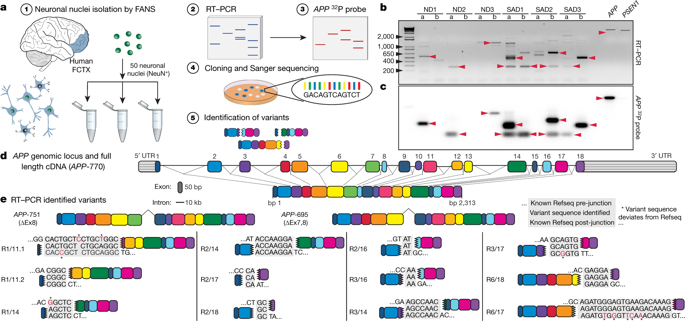Our official English website, www.x-mol.net, welcomes your feedback! (Note: you will need to create a separate account there.)
Somatic APP gene recombination in Alzheimer’s disease and normal neurons
Nature ( IF 64.8 ) Pub Date : 2018-11-01 , DOI: 10.1038/s41586-018-0718-6 Ming-Hsiang Lee 1 , Benjamin Siddoway 1 , Gwendolyn E Kaeser 1, 2 , Igor Segota 1 , Richard Rivera 1 , William J Romanow 1 , Christine S Liu 1, 2 , Chris Park 1, 2 , Grace Kennedy 1 , Tao Long 1 , Jerold Chun 1
Nature ( IF 64.8 ) Pub Date : 2018-11-01 , DOI: 10.1038/s41586-018-0718-6 Ming-Hsiang Lee 1 , Benjamin Siddoway 1 , Gwendolyn E Kaeser 1, 2 , Igor Segota 1 , Richard Rivera 1 , William J Romanow 1 , Christine S Liu 1, 2 , Chris Park 1, 2 , Grace Kennedy 1 , Tao Long 1 , Jerold Chun 1
Affiliation

|
The diversity and complexity of the human brain are widely assumed to be encoded within a constant genome. Somatic gene recombination, which changes germline DNA sequences to increase molecular diversity, could theoretically alter this code but has not been documented in the brain, to our knowledge. Here we describe recombination of the Alzheimer’s disease-related gene APP, which encodes amyloid precursor protein, in human neurons, occurring mosaically as thousands of variant ‘genomic cDNAs’ (gencDNAs). gencDNAs lacked introns and ranged from full-length cDNA copies of expressed, brain-specific RNA splice variants to myriad smaller forms that contained intra-exonic junctions, insertions, deletions, and/or single nucleotide variations. DNA in situ hybridization identified gencDNAs within single neurons that were distinct from wild-type loci and absent from non-neuronal cells. Mechanistic studies supported neuronal ‘retro-insertion’ of RNA to produce gencDNAs; this process involved transcription, DNA breaks, reverse transcriptase activity, and age. Neurons from individuals with sporadic Alzheimer’s disease showed increased gencDNA diversity, including eleven mutations known to be associated with familial Alzheimer’s disease that were absent from healthy neurons. Neuronal gene recombination may allow ‘recording’ of neural activity for selective ‘playback’ of preferred gene variants whose expression bypasses splicing; this has implications for cellular diversity, learning and memory, plasticity, and diseases of the human brain.The gene for the amyloid precursor protein (APP) shows somatic gene recombination in neurons, and the abundance and diversity of APP variants is increased in neurons from individuals with Alzheimer’s disease.
中文翻译:

阿尔茨海默病和正常神经元中的体细胞APP基因重组
人们普遍认为人类大脑的多样性和复杂性是在一个恒定的基因组中编码的。体细胞基因重组,改变种系 DNA 序列以增加分子多样性,理论上可以改变这个代码,但据我们所知,尚未在大脑中记录。在这里,我们描述了人类神经元中阿尔茨海默病相关基因 APP 的重组,该基因编码淀粉样前体蛋白,以镶嵌方式出现为数千个变异的“基因组 cDNA”(gencDNA)。gencDNA 缺乏内含子,范围从表达的大脑特异性 RNA 剪接变体的全长 cDNA 拷贝到包含外显子内连接、插入、缺失和/或单核苷酸变异的无数更小的形式。DNA 原位杂交鉴定了单个神经元内的 gencDNA,这些神经元不同于野生型基因座,并且在非神经元细胞中不存在。机制研究支持神经元“逆向插入”RNA 以产生 gencDNA;这个过程涉及转录、DNA 断裂、逆转录酶活性和年龄。来自散发性阿尔茨海默病患者的神经元表现出增加的 gencDNA 多样性,其中包括 11 个已知与家族性阿尔茨海默病相关的突变,而健康神经元中不存在这些突变。神经元基因重组可能允许“记录”神经活动,以选择性地“回放”其表达绕过剪接的首选基因变异;这对人脑的细胞多样性、学习和记忆、可塑性和疾病都有影响。
更新日期:2018-11-01
中文翻译:

阿尔茨海默病和正常神经元中的体细胞APP基因重组
人们普遍认为人类大脑的多样性和复杂性是在一个恒定的基因组中编码的。体细胞基因重组,改变种系 DNA 序列以增加分子多样性,理论上可以改变这个代码,但据我们所知,尚未在大脑中记录。在这里,我们描述了人类神经元中阿尔茨海默病相关基因 APP 的重组,该基因编码淀粉样前体蛋白,以镶嵌方式出现为数千个变异的“基因组 cDNA”(gencDNA)。gencDNA 缺乏内含子,范围从表达的大脑特异性 RNA 剪接变体的全长 cDNA 拷贝到包含外显子内连接、插入、缺失和/或单核苷酸变异的无数更小的形式。DNA 原位杂交鉴定了单个神经元内的 gencDNA,这些神经元不同于野生型基因座,并且在非神经元细胞中不存在。机制研究支持神经元“逆向插入”RNA 以产生 gencDNA;这个过程涉及转录、DNA 断裂、逆转录酶活性和年龄。来自散发性阿尔茨海默病患者的神经元表现出增加的 gencDNA 多样性,其中包括 11 个已知与家族性阿尔茨海默病相关的突变,而健康神经元中不存在这些突变。神经元基因重组可能允许“记录”神经活动,以选择性地“回放”其表达绕过剪接的首选基因变异;这对人脑的细胞多样性、学习和记忆、可塑性和疾病都有影响。



























 京公网安备 11010802027423号
京公网安备 11010802027423号